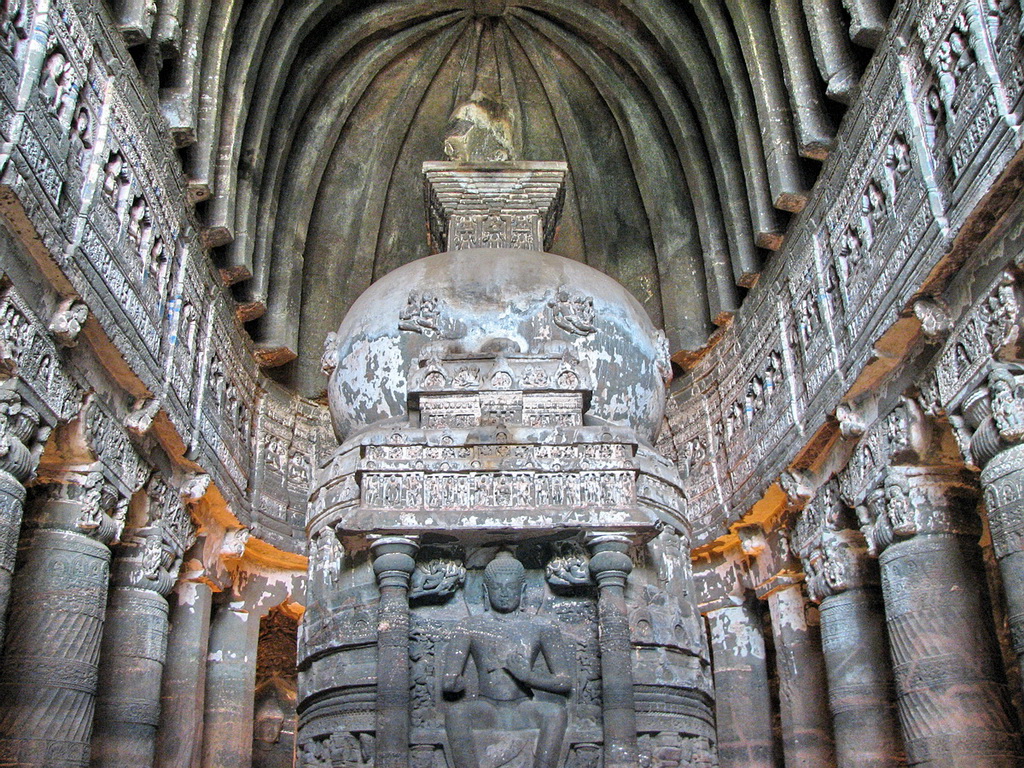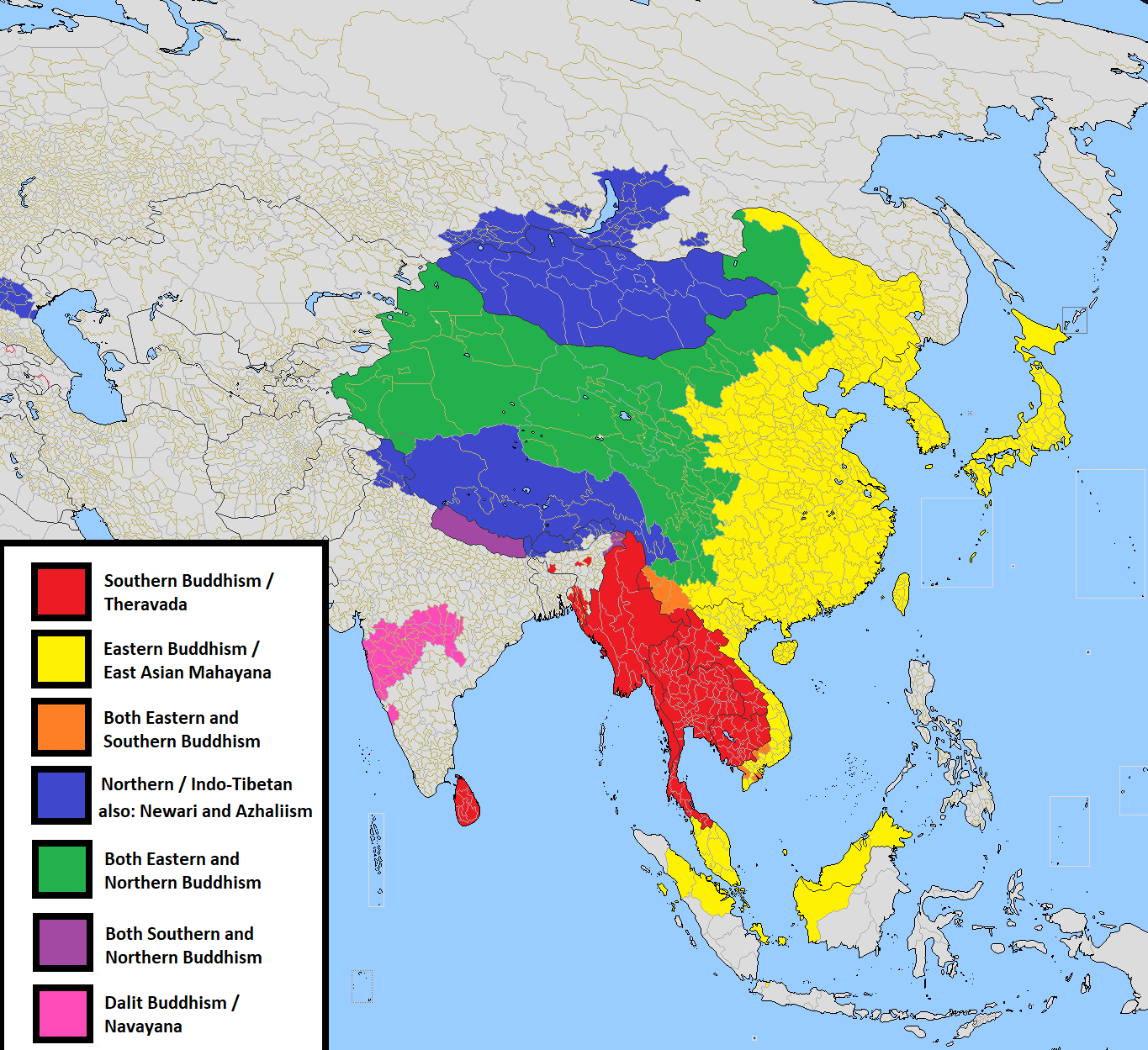|
Ekavyāvahārika
The Ekavyāvahārika ( sa, एकव्यावहारिक; ) was one of the early Buddhist schools, and is thought to have separated from the Mahāsāṃghika sect during the reign of Aśoka. History Relationship to Mahāsāṃghika Tāranātha viewed the Ekavyāvahārikas, Lokottaravādins, and Gokulikas as being essentially the same. He even viewed ''Ekavyāvahārika'' as being a general term for the Mahāsāṃghikas. The Ekavyāvahārikas, Gokulikas, and Lokottaravādins are the three groups that emerged from the first split in the Mahāsāṃghika sect. A.K. Warder notes that the Ekavyāvahārikas were hardly known in later times and may have simply have been considered part of the Mahāsāṃghika. Early history The 6th century CE Indian monk Paramārtha wrote that 200 years after the parinirvāṇa of the Buddha, much of the Mahāsāṃghika school moved north of Rājagṛha, and were divided over whether the Mahāyāna teachings should be incorporated formally ... [...More Info...] [...Related Items...] OR: [Wikipedia] [Google] [Baidu] |
Lokottaravāda
The Lokottaravāda (Sanskrit, लोकोत्तरवाद; ) was one of the early Buddhist schools according to Mahayana doxological sources compiled by Bhāviveka, Vinitadeva and others, and was a subgroup which emerged from the Mahāsāṃghika. Etymology The name ''Lokottaravāda'' means those who follow the supramundane (Skt. ''lokottara''), or transcendent, teachings. Despite bearing this name, all sub-sects of the Mahāsāṃghikas seem to have accepted forms of supramundane or transcendent teachings. Early history The ''Śāriputraparipṛcchā'' and the ''Samayabhedoparacanacakra'' both suggest that the Lokottaravāda had their origins with the Ekavyāvahārikas and the Kukkuṭikas. While the Mahāsāṃghikas initially flourished in the region around Magadha, the Lokottaravādins are known to have flourished in the Northwest. The 6th century CE Indian monk Paramārtha wrote that 200 years after the of the Buddha, much of the school moved north of Rājagṛh ... [...More Info...] [...Related Items...] OR: [Wikipedia] [Google] [Baidu] |
Mahāsāṃghika
The Mahāsāṃghika (Brahmi: 𑀫𑀳𑀸𑀲𑀸𑀁𑀖𑀺𑀓, "of the Great Sangha", ) was one of the early Buddhist schools. Interest in the origins of the Mahāsāṃghika school lies in the fact that their Vinaya recension appears in several ways to represent an older redaction overall. Many scholars also look to the Mahāsāṃghika branch for the initial development of Mahayana and Vajrayana Buddhism. Location The original center of the Mahāsāṃghika sect was in Magadha, but they also maintained important centers such as in Mathura and Karli. The Kukkuṭikas were situated in eastern India around Vārāṇasī and Pāṭaliputra and the Bahuśrutīya in Kośala, Andhra, and Gandhara. The Lokottaravāda subschool itself claimed to be of the 'Middle Country', i.e. Ganges Basin region in the north of India. The Mahāsāṃghikas and the Lokottaravāda subschool also had centres in the Gandhara region.The Ekavyāvahārika are not known from later times. The Caitik ... [...More Info...] [...Related Items...] OR: [Wikipedia] [Google] [Baidu] |
Four Noble Truths
In Buddhism, the Four Noble Truths (Sanskrit: ; pi, cattāri ariyasaccāni; "The four Arya satyas") are "the truths of the Noble Ones", the truths or realities for the "spiritually worthy ones".[aFour Noble Truths: BUDDHIST PHILOSOPHY Encyclopaedia Britannica, Quote: "Although the term Four Noble Truths is well known in English, it is a misleading translation of the Pali term Chattari-ariya-saccani (Sanskrit: Chatvari-arya-satyani), because noble (Pali: ariya; Sanskrit: arya) refers not to the truths themselves but to those who recognize and understand them. A more accurate rendering, therefore, might be “four truths for the [spiritually] noble” [...]";[''Arhat (Buddhism)'' Encyclopædia Britannica The truths are: * '' dukkha'' (literally "suffering"; here "unsatisfactoriness") is an innate characteristic of existence in the realm of '' samsara''; [...More Info...] [...Related Items...] OR: [Wikipedia] [Google] [Baidu] |
Buddhahood
In Buddhism, Buddha (; Pali, Sanskrit: 𑀩𑀼𑀤𑁆𑀥, बुद्ध), "awakened one", is a title for those who are awake, and have attained nirvana and Buddhahood through their own efforts and insight, without a teacher to point out the dharma (Sanskrit 𑀥𑀭𑁆𑀫; Pali ''dhamma''; "right way of living"). The title is most commonly used for Gautama Buddha, the founder of Buddhism, who is often simply known as "the Buddha". Buddhahood ( sa, 𑀩𑀼𑀤𑁆𑀥𑀢𑁆𑀯, buddhatva; pi, buddhatta or ; ) is the condition and rank of a buddha "awakened one". This highest spiritual state of being is also termed ''sammā-sambodhi'' (skt. samyaksaṃbodhi 'full complete awakening'). The title is also used for other beings who have achieved ''bodhi'' (awakening) and ''moksha'' (release from craving), such as the other human Buddhas who achieved enlightenment before Gautama, the five celestial Buddhas worshiped primarily in Mahayana, and the bodhisattva named M ... [...More Info...] [...Related Items...] OR: [Wikipedia] [Google] [Baidu] |
Tripiṭaka
''Tipiṭaka'' () or ''Tripiṭaka'' () or ''තිපිටක'' (), meaning "Triple Basket", is the traditional term for ancient collections of Buddhist sacred scriptures. The Pāli Canon maintained by the Theravāda tradition in Southeast Asia, the Chinese Buddhist Canon maintained by the East Asian Buddhist tradition, and the Tibetan Buddhist Canon maintained by the Tibetan Buddhist tradition are some of the most important ''Tripiṭaka'' in contemporary Buddhist world. ''Tripiṭaka'' has become a term used for many schools' collections, although their general divisions do not match a strict division into three piṭakas.Mizuno, ''Essentials of Buddhism'', 1972, English version by Ritik Bhadana, Tokyo, 1996 Etymology ''Tripiṭaka'' (Sanskrit: त्रिपिटक), or ''Tipiṭaka'' (Pāli), means "Three Baskets". It is a compound Sanskrit word of ''tri'' (त्रि) or Pāli word ''ti'', meaning "three", and ''piṭaka'' (पिटक) or ''piṭa'' ... [...More Info...] [...Related Items...] OR: [Wikipedia] [Google] [Baidu] |
Dharma Wheel
The dharmachakra (Sanskrit: धर्मचक्र; Pali: ''dhammacakka'') or wheel of dharma is a widespread symbol used in Indian religions such as Hinduism, Jainism, and especially Buddhism.John C. Huntington, Dina Bangdel, ''The Circle of Bliss: Buddhist Meditational Art,'' p. 524. Historically, the dharmachakra was often used as a decoration in East Asian statues and inscriptions, beginning with the earliest period of East Asian culture to the present. It remains a major symbol of the Buddhist religion today. Etymology The Sanskrit noun '' dharma'' ( धर्म ) is a derivation from the root ''dhṛ'' 'to hold, maintain, keep',Monier Williams, ''A Sanskrit Dictionary'' (1899): "to hold, bear (also: bring forth), carry, maintain, preserve, keep, possess, have, use, employ, practise, undergo" and means 'what is established or firm' and hence 'law'. It is derived from the Vedic Sanskrit ''n''-stem ''dharman-'' with the meaning "bearer, supporter" in the historical V ... [...More Info...] [...Related Items...] OR: [Wikipedia] [Google] [Baidu] |
Schools Of Buddhism
The schools of Buddhism are the various institutional and doctrinal divisions of Buddhism that have existed from ancient times up to the present. The classification and nature of various doctrinal, philosophical or cultural facets of the schools of Buddhism is vague and has been interpreted in many different ways, often due to the sheer number (perhaps thousands) of different sects, subsects, movements, etc. that have made up or currently make up the whole of Buddhist traditions. The sectarian and conceptual divisions of Buddhist thought are part of the modern framework of Buddhist studies, as well as comparative religion in Asia. From a largely English-language standpoint, and to some extent in most of Western academia, Buddhism is separated into two groups: Theravāda, literally "the Teaching of the Elders" or "the Ancient Teaching," and Mahāyāna, literally the "Great Vehicle." The most common classification among scholars is threefold: Theravāda, Mahāyāna and Vajrayāna. ... [...More Info...] [...Related Items...] OR: [Wikipedia] [Google] [Baidu] |
Nikaya Buddhism
The term Nikāya Buddhism was coined by Masatoshi Nagatomi as a non-derogatory substitute for Hinayana, meaning the early Buddhist schools. Examples of these groups are pre-sectarian Buddhism and the early Buddhist schools. Some scholars exclude pre-sectarian Buddhism when using the term. The term Theravada refers to Buddhist practices based on these early teachings, as preserved in the Pāli Canon. Etymology ''Nikāya'' is a Pali word meaning "group" or "assemblage", referring to the collection of early Buddhist schools or non-Mahayana schools. In Indian Buddhism Overview Early Buddhism in India is generally divided into various monastic fraternities, or nikāyas. Conventionally numbering eighteen, the actual count varied over time. The doctrinal orientation of each school differed somewhat, as did the number of piṭakas in their canon. An example of this is the Dharmaguptaka, which included a Bodhisattva Piṭaka and a Dhāraṇī Piṭaka. In the Mahāsāṃghika b ... [...More Info...] [...Related Items...] OR: [Wikipedia] [Google] [Baidu] |
Early Buddhist Schools
The early Buddhist schools are those schools into which the Buddhist monastic saṅgha split early in the history of Buddhism. The divisions were originally due to differences in Vinaya and later also due to doctrinal differences and geographical separation of groups of monks. The original saṅgha split into the first early schools (generally believed to be the Sthavira nikāya and the Mahāsāṃghika) during or after the reign of Aśoka. Later, these first early schools were further divided into schools such as the Sarvāstivādins, the Dharmaguptakas, and the Vibhajyavāda, and ended up numbering 18 or 20 schools according to traditional accounts. The textual material shared by the early schools is often termed the Early Buddhist Texts and these are an important source for understanding their doctrinal similarities and differences. Formation and development The first council According to the scriptures (''Cullavagga'' XI.1 ff), three months after the parinirvana o ... [...More Info...] [...Related Items...] OR: [Wikipedia] [Google] [Baidu] |
Avatamsaka Sutra
The ' (IAST, sa, 𑀅𑀯𑀢𑀁𑀲𑀓 𑀲𑀽𑀢𑁆𑀭) or ''Buddhāvataṃsaka-nāma-mahāvaipulya-sūtra (The Mahāvaipulya Sūtra named “Buddhāvataṃsaka”)'' is one of the most influential Mahāyāna sutras of East Asian Buddhism. In Classical Sanskrit, ''avataṃsaka'' means garland, wreath, or any circular ornament, such as an earring.'''' Thus, the title may be rendered in English as ''A Garland of Buddhas'', ''Buddha Ornaments'', or ''Buddha’s Garland''. In Buddhist Hybrid Sanskrit, the term ''avataṃsaka'' means “a great number,” “a multitude,” or “a collection.” This is matched by the Tibetan title of the sutra, which is ''A Multitude of Buddhas'' (''""''). The ''Buddhāvataṃsaka'' has been described by the translator Thomas Cleary "the most grandiose, the most comprehensive, and the most beautifully arrayed of the Buddhist scriptures." The ' describes a cosmos of infinite realms upon realms, mutually containing one another. This sut ... [...More Info...] [...Related Items...] OR: [Wikipedia] [Google] [Baidu] |
Lotus Sūtra
The ''Lotus Sūtra'' ( zh, 妙法蓮華經; sa, सद्धर्मपुण्डरीकसूत्रम्, translit=Saddharma Puṇḍarīka Sūtram, lit=Sūtra on the White Lotus of the True Dharma, italic=) is one of the most influential and venerated Buddhist Mahāyāna sūtras. It is the main scripture on which the Tiantai, Tendai, Cheontae, and Nichiren schools of Buddhism were established. It is also influential for other East Asian Buddhist schools, such as Zen. According to the British Buddhologist Paul Williams, "For many Buddhists in East Asia since early times, the ''Lotus Sūtra'' contains the final teaching of Shakyamuni Buddha—complete and sufficient for salvation." The American Buddhologist Donald S. Lopez Jr. writes that the ''Lotus Sūtra'' "is arguably the most famous of all Buddhist texts," presenting "a radical re-vision of both the Buddhist path and of the person of the Buddha." Two central teachings of the ''Lotus Sūtra'' have been very inf ... [...More Info...] [...Related Items...] OR: [Wikipedia] [Google] [Baidu] |
Dharmakāya
The ''dharmakāya'' ( sa, धर्म काय, "truth body" or "reality body", zh, t=法身, p=fǎshēn, ) is one of the three bodies (''trikāya'') of a buddha in Mahāyāna Buddhism. The ''dharmakāya'' constitutes the unmanifested, "inconceivable" (''acintya'') aspect of a buddha out of which buddhas arise and to which they return after their dissolution. Buddhas are manifestations of the ''dharmakāya'' called the ''nirmāṇakāya'', "transformation body". The Dhammakāya tradition of Thailand and the ''Tathāgatagarbha sūtras'' of the ancient Indian tradition view the ''dharmakāya'' as the '' ātman'' (true self) of the Buddha present within all beings. Origins and development Pali Canon In the Pāli Canon, Gautama Buddha tells Vasettha that the Tathāgata (the Buddha) is ''dhammakaya'', the "truth-body" or the "embodiment of truth", as well as ''dharmabhuta'', "truth-become", that is, "one who has become truth." During the Buddha's life great veneration was ... [...More Info...] [...Related Items...] OR: [Wikipedia] [Google] [Baidu] |




.jpeg/1200px-Gandhara_Buddha_(tnm).jpeg)



_-_BL_Or._7377.jpg)
